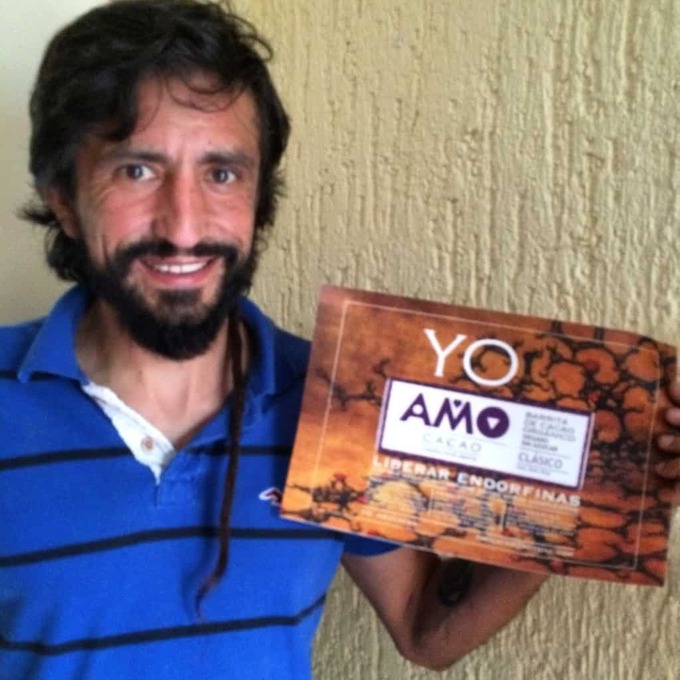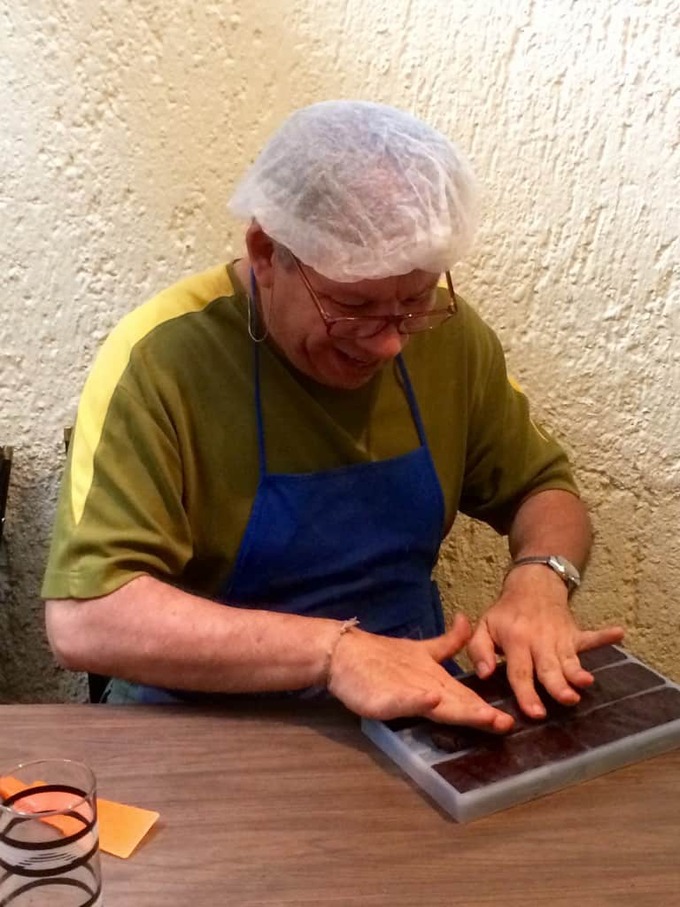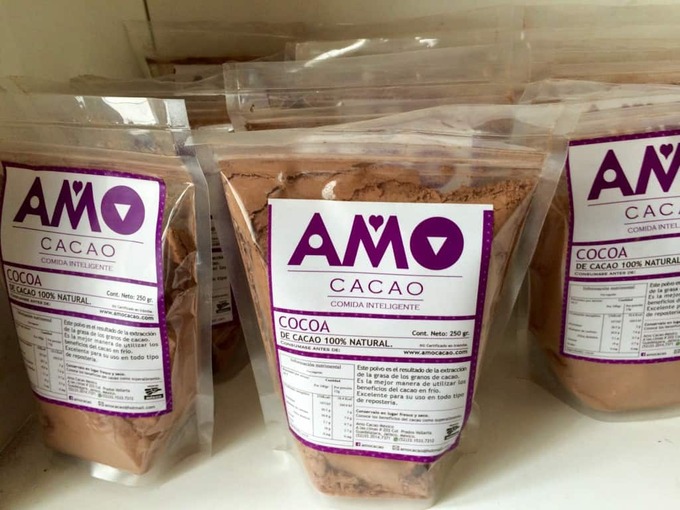I had the pleasure of visiting two completely opposite types of chocolate shops while I was in Guadalajara, Mexico. It was really interesting to see how each makes their chocolate products and the contrast was overwhelming. This post is about the chocolate philosophy of AMO Cacao.

Fernel Bobadilla is the brains behind AMO Cacao. Educated at Simon Fraser University in Vancouver, Canada as a documentary filmmaker, the self-proclaimed idealist has lived in several places around the world including the Okanagan Valley in British Columbia, where he worked as a cherry picker and “learned about organic farming, better food, and a better lifestyle.”
I met Fernel at the Cacao and Chocolate Festival at the Botanical Gardens in Puerto Vallarta in 2015. He and I were both speakers at the event, and he told me then that I must come to Guadalajara and see how he and his team make chocolate. I accepted the invitation, and last October visited the AMO Cacao chocolate kitchen, where I saw a group of happy people working together to create the purest chocolate on the planet.


Fernel likes to think of cacao beans as grains–partly because in the Mexican language, there is no exact word that translates to what we think of when we say cacao or cocoa beans. At AMO Cacao, the cocoa beans are not fermented. They are raw beans that have been washed and sun dried for one to two days, and are then low-temperature roasted for 12 minutes in two frying pans on small burners in a tiny kitchen. This is chocolate in its most primitive form, but the resulting product is delicious authentic chocolate that truly is a health food with a very strong social conscience.
AMO Cacao employs intellectually challenged individuals to help make their chocolate. The company also puts great emphasis on the sustainability of its chocolate making endeavours. “Sustainability and social responsibility are key components to our operation,” says Fernel, who emphasizes that AMO Cacao is not making and selling chocolate. It is selling cacao in as pure a form as possible.
making cacao into a healthy line of chocolate products
At present, AMO Cacao is buying its cacao in Chiapas, Mexico, from a fellow who operates an Agro-Ecological Centre where he connects chocolate makers like AMO with the growers who are producing the finest quality certified organic cacao. “My mission is to make cacao into a healthy line of chocolate products, and eventually, cacao elixirs, so that people can dance without drugs.” Fernel is referring to the magical components of cacao, and the fact that it contains cannabinoid receptors that are similar to THC found in marijuana, producing a mildly psychoactive effect when taken in a pure form. Cacao is indeed your feel good, happy place food if processed purely without artificial additives or much sugar.

Fernel believes that by reintroducing pure cacao into the Mexican culture, it will produce long-lasting effects. “My focus is on teaching the Mexicans how to rediscover cacao,” says Fernel. “It has been in our genes and our culture for 3,000 years. It will change our humour, produce less violence, and less crime.” To help achieve his dream, Fernel launched a program called Planta Cacao in which he is encouraging anyone with land to grow cacao.
“If you have land that you are not using–even if it’s just one hectare–we will help you plant the cacao and improve the local economy,” says Fernel. Planta Cacao is targeting land owners in the four states of Jalisco, Nayarit, Michoachan, and Colyma. “We are co-creating a new network of cacao in Mexico.”
At the time of my visit last October, Planta Cacao had 8,000 cacao trees growing at three different locations at different stages of growth. I visited their location in San Pancho near Puerto Vallarta and witnessed how the cacao grains are sprouted in water and then planted in soil mixed with coconut fibre, to create a substance similar to peat moss. It was very exciting to see this community driven grassroots project that is using cacao to transform the Mexican landscape and culture.

And that is what Chocolatour is all about. Visiting different parts of the world to see how cacao and chocolate have affected and in some cases, transformed the local culture. Fernel wishes to thank his father who helped fund the AMO Cacao project, which launched a socially responsible company where Fernel works with his two sisters (one is in charge of production, and the other in charge of sales,) but also spawned a whole new movement that is helping Mexico rediscover the magic and importance of cacao as a way of life.
“Cacao used to be the gold of the Mexican people 3,000 years ago, and we can make it our gold again–if we handle it right,” says Fernel. Currently, AMO Cacao is working with nutritionists and psychologists to develop an Alzheimer Bar to help with cognitive powers. The key ingredients of the bar are curcumin and agave syrup, which combined with the cacao, have a very positive effect on neuro transmitters. AMO Cacao is also working on a bar to help cancer patients and an energy bar featuring matcha and Peruvian maca. Look for more about AMO Cacao in Volume II of Chocolatour.

This is to inform you that makinde cocoa farm is here again to make a partner with a successful business personal that can finance business with experience and understanding. Makinde cocoa establishment where thousands of tonnes are produce per year you can be a bulk buyer, partner, makinde cocoa establishment is the best around the south-south origin in Nigeria. We produce the best and a well-trained employee in agricultural science. We ensure that our cocoa beans a weight and fresh. Be a partner from anywhere makinde is ready to accept, bulk buy most
wanted in outside Nigeria.
Makinde cocoa farm is located in fari forest ogun state for more information’s email MR. ADEKUNLE JULIUS at adekunlejuliuscocoadealer@gmail.com him is going to furnish you the own info.
To be a partner you need to make the following: you must have experience in the world of cocoa. A partner will be ready to make an affidavit in any high court. Come let make cocoa the best and the best business THANKS.
Thanks for this nice post. Keep it up. 🙂
Its very cool that Fernel has such a great initiative attached to his chocolateering. Sustainable chocolating, its a location I would visit because its unique
What a great story and a great initiative. The world needs more people like Fernel! If I ever make it to Mexico I will definitely try and find some AMO Cacao
Thanks for your comment, Elizabeth. Fernel is indeed an inspirational man filled with passion. It shows in the chocolate products he is making as they are pure and the flavours very intentional.
I love this! Sounds like a very special experience and I love the responsible and sustainable approach of it. Very inspiring!!
Thanks for your comment, Liesbeth. I am happy to share Fernel’s story. It is the mission of Chocolatour to seek out and feature other chocolate makers just like the team at AMO Cacao who are doing innovative and socially responsible things with chocolate. A few of them have already been profiled on this site and in volume I of Chocolatour. Stay tuned for volume II!
Oh I love it that is considered healthy! How much of it can I eat per day please!!!
Hi Chandi and thanks for your comment. Having a small bar that is about 25-grams and of 70% pure cocoa or higher is an ideal amount, or if you have a large pure dark chocolate bar, just one or two squares is the maximum you should eat per day. If you eat cocoa nibs, there is no limit, as they are pure cocoa and you will reap the most health benefits from them. Enjoy!
It’s the end of the week, so I’m going to sneak in a slightly OT comment. Doreen, have you ever written a post discussing the difference(s) between cacao, cocoa, and chocolate, as you would define these terms? I’m sure that many would find such a post interesting.
Hello, Andy. I do cover this in detail in my book, and will again in volume II of Chocolatour.
But to briefly answer your question … chocolate grows on trees! The Theobrama cacao tree produces pods the size of small melons that contain 30-50 beans. Technically, they are cacao pods containing cacao beans. But in today’s world, we interchange the words cacao and cocoa, and in most places, they are called cocoa plantations, cacao trees, cocoa pods and cocoa beans. The beans are fermented, dried, peeled (winnowed) and processed to make chocolate. If you search “growing cacao” on this blog, it will bring up some of the posts where I have visited cacao farms and written about it in more detail.
Wow, this is really amazing! I love chocolates a lot and I often wonder how they’re made/ I haven’t tried touring around a chocolate factory but I would definitely love to one day. Fernel Bobadilla’s chocolate factory story is definitely inspiring.
Hi Karla and thanks for your comment.
AMO Cacao doesn’t have a factory. It is a small chocolate workshop in a residential neighbourhood of Guadalajara. I’ve been to massive chocolate factories in Switzerland and smaller chocolate factories elsewhere and that is an entirely different experience as they are subject to government regulations for exporting their products. Much more sterile and industrial, and for the most part, the chocolate reflects that, as the bars are not as ‘fresh’ tasting. Artisan chocolate is indeed very hands-on and the shops are usually small and the smell of chocolate intense! But definitely worth the experience, if you ever get the chance to tour a chocolate factory anywhere–large or small.
I bet it taste so good! Would love to try making chocolates! I’m not that super fan but this one looks healthy and yummy!!
Hi Cai. Yes, AMO Cacao is more of a health food than a chocolate treat. This is chocolate in its purest form.
Hi Dorreen; good for you. Its important to bring awareness to those who are trying to do things the right way and create a new way of life for the local people. your writing kept me interested. I wish them all the best, max
Thx for stopping by the blog, Max. It’s been a long while!
I’m glad you were inspired by the story of AMO Cacao. This is the reason I do what I do.
Very interesting post Doreen! Funnily enough, I go to Simon Fraser University (where Fernel went). What a small world!
Very cool, Christina. It is indeed a small world!
I believe Fernel will be dropping by the post next week to read the comments. They’re closed this week for the Easter celebrations.
Another great post. I learn something every time I come here. I am a person who likes to learn tidbits of knowledge. My life is filled with trying to learn new information, and your posts always seem to provide me with some more interesting info. Thanks for sharing this with us.
What a wonderful compliment, William! It is indeed the mission statement of Chocolatour to “educate, entertain, and entice chocolate lovers to gain greater knowledge of the world of chocolate through travel.” I am so glad I am fulfilling that goal, based on your comments.
Your posts always amaze me! I never think that chocolate would have so many kinds of stories, bringing people together in so many different ways. 🙂 Its wonderful to see everyone working together so merrily, and have goals like the Alzheimer Bar and one to help cancer patients. Amazing, much love to AMO cacao!
Hi Mar and thanks for your comment. What you said is the precise reason why Chocolatour has turned into a trilogy! When I first started writing the book, it was to be just one book. Then, once I became immersed in the world of artisanal chocolate, I realized just how many stories there were to tell. So it will become a trilogy of three volumes, scouring the world for exciting stories to tell. Thanks for your enthusiasm of my work. 🙂
A great post! I love chocolate and reading about “authentic chocolate that truly is a health food with a very strong social conscience” is heartening, especially after hearing horror stories about the conditions for workers planting and harvesting in other countries. Such wonderful comments from readers too! I especially like what Lenie had to say about the very human philosophy behind this remarkable business. Thanks for sharing.
Thx so much for your comment, Ramona. I think this is your first visit to my site?
I believe West Africa is the only region with problems of child labour with respect to cacao production. I have not come across any such problems in any of the countries I have visited to date for my chocolate research.
Yes, my first visit. 🙂 So great to “meet” you through LinkedIn.
What a great tale of a grassroots project. I hope that we’ll be able to someday get this cacao in the USA. The more pure products I can use in my baking, the happier I am to bake!
Hi Rose. For now, see if you can find the Camino brand for your baking. If is excellent!
I’ll search for the Camino brand. As is, I use organic carob powder for my cocoa needs. No caffeine! But, not chocolate!
Hi Rose. I forgot to mention that the Camino brand is generally available at healthfood stores as it organic and a truly natural brand made from cocoa beans grown in South America. Have a super Easter weekend.
Doreen — this is such an interesting post. I didn’t know anything about cacao except as an ingredient of chocolate. I applaud their hiring intellectually challenged individuals and their focus on sustainability.
Thanks so much, Jeannette. I will have a full chapter on sustainable chocolate and the concept of sustainability in the next volume of Chocolatour, as I have learned so much from Fernel and other chocolate makers who make chocolate with a conscience.
Doreen — FYI, my nephew Tom Paladino is a pioneer in sustainability and wrote the first LEED standards. If you’re interested, here is a link to his website http://www.paladinoandco.com/
Thx for this, Jeannette. I will check out your nephew’s site.
What an inspiring story and I applaud the direction they’ve taken with their business. And to be honest, I applaud you Doreen for your adventurous spirit and the courage to travel around Mexico because with all of the stories we’ve heard about violence south of the border in recent years I’m not really that anxious to go back.
Hi Marty and thx for your comment.
I have to tell you. There are a LOT more violent places in the world than Mexico! I spent a month in MX in 2015 and was not afraid for one minute. Yes, there is crime, but for the most, part prudent travelers are safe and most welcome.
Appreciate the way that AMO Cacao had infused a social consciousness into every aspect of their business. For me the positioning of chocolate as a healthy product is something new.
Hi Ken and welcome back!
Ken, the wonderful thing about chocolate is that it can be sweet candy that has no health benefits whatsoever, to the healthiest food on the planet on the other end of the scale. And everything in between.
Hi Doreen, I just love his line about dancing without drugs. That just be some great chocolate 🙂 actually just really like everything I read about this company and the work they are doing in the community, changing culture, reducing violence…its all good. As I’m sure the chocolate is too! It’s a double treat when a company makes a great product and does good in the community.
Hi Susan and thanks for your comment.
I really get “high” when I meet folks like Fernel who are truly passionate about what they are doing. It really makes my ‘job’ worthwhile. Thx for stopping by.
I use my money in the marketplace to influence future availability of organic produce, including chocolate. Fortunately, here in Vancouver, I am able to buy all “organic” food. “Let food be thy medicine and medicine be thy food,” said Hippocrates. Food with Roundup (glyphosate) and other pesticides, herbicides, etc. have the potential to be cancer-inducing. If I can’t find organics in a store, I will ask the server if they sell organic produce, as communication generates awareness.
Nice post, Doreen. Another great adventure!
I totally agree with you, Esther. Organic, fair trade and sustainable are the key words to look for when we are choosing our food (and chocolate!)
Thx for stopping by and sharing your thoughts.
Doreen, I’ve died and gone to heaven! I love the idea of the Alzhiemers Bar.
Thanks for your enthusiasm, Marteen, and welcome to the blog! I believe it is your first time here. As an avid chocolate lover who likes to travel, I think you will find many tasty posts here. Please subscribe and join the fun. 🙂
What a great goal for this company. I’m so glad that you met Fernal and brought this company to our attention.
You’re welcome, TammyJo. It is a great story.
This was a fascinating read… I love the possibility that eating chocolate in its purest form could help prevent Alzheimer’s and cancer. Kudos to this small company for all they are doing to make a difference. Did you bring back some of the cacao powder? I imagine the hot chocolate made from it would be divine!
Hi Debbie and thx for your comment. No, I didn’t bring any of the pure cocoa home, but I did bring a selection of the chocolate bars and cocoa beans (grains.)
What a responsible group of people! A truly inspiring post.
Thanks, Bev. Yes, the world of chocolate is comprised of many passionate and fascinating people. I am so fortunate to have a good percentage of them.
Doreen, I love this guy and his philosophy. First, hiring developmentally challenged adults – that is so important to their self-confidence and feeling of worth; second, “If you have land that you are not using–even if it’s just one hectare–we will help you plant the cacao and improve the local economy,” That can be such a turning point for a community and he is absolutely right, give people an honest way to make a living and crime will be reduced dramatically. (Why can’t politicians understand that?)
Hi Lenie. I’m so glad you enjoyed this post. I certainly enjoyed writing it and had to hold back on writing more as it was getting so long! That’s never happened to me when writing a post before.
You had the privilege of visiting two chocolate shops – you were definitely spoilt for choice!
Interesting to read about the chocolate making process. I have never given it much thought – just pick up a bar or two in the shop.
Thank you for giving us an insight.
Hi Phoencia and thanks for your comment.
I visited many chocolate shops on my time in Mexico. But I had visited two in metro Guadalajara. I was going to combine both in this post, but once I got going on AMO Cacao, I knew I had to tell their story in more depth. Stay tuned for more insights into the truffle making process.
What a wonderful post. I really love the dedication to humanity that goes into Fernel’s business!
Thanks, Linda. Me, too!
As I was writing this post, it brought back the interview I had done with Fernel and just how many things he is doing to change the way Mexicans think of chocolate and cacao. This should be an amazing year for Planta Cacao and AMO Cacao. Stay tuned for updates!
I like the picture of the team with the freshly roasted cacao. It is great when someone has a business that they can take pride in. I was a bit taken aback with the photograph of the man pressing the cacao with his bare hands. Was that before it was cooked? Needless to say, it looks like the end product would be yummy.
Erica, almost all the artisan shops I have visited wrap their bars by hand. It is very “hands-on” and in Mexico that is taken very literally. But I can assure you that the AMO Cacao chocolate workshop was spotless and extremely clean in all it’s practices.
Doreen, this was a fascinating post. I like the sustainability and social responsibility focus of AMO Cacao as well as their commitment to purity in their product. The development of bars with specific health aims is interesting. Are their products available anywhere in Canada?
Hi Donna. No exporting at this point in time. Glad you enjoyed the post. I will have an update on AMO in Vol II of Chocokatour, as their story is definitely new and unfolding.
What an experience. Hats off to Fernel Bobadilla for trying to come up with something that is healthy, productive and bring back the roots to Mexico. So was the Cacao sweet or bitter? Were able to take some home? With the good properties of Cacao is it exported to the US?
Hi Arleen. The AMO Cacao is not bitter as if has not been fermented. Fernel believes that fermenting increases the bitterness of the chocolate. And it definitely is not sweet.
Unfortunately, not exported to the US at this time.
Very interesting, can we find AMO Cacao in the U.S.?
Not at this time, Sabrina. That’s what Chocolatour is all about. Encouraging chocolate lovers to plan travel around chocolate. Or at least to develop a greater understanding of the world of artisan chocolate. I will try and cover more American chocolate makers in the future, but it’s not quite the same as experiencing the chocolate in the same place that the cacao is grown.